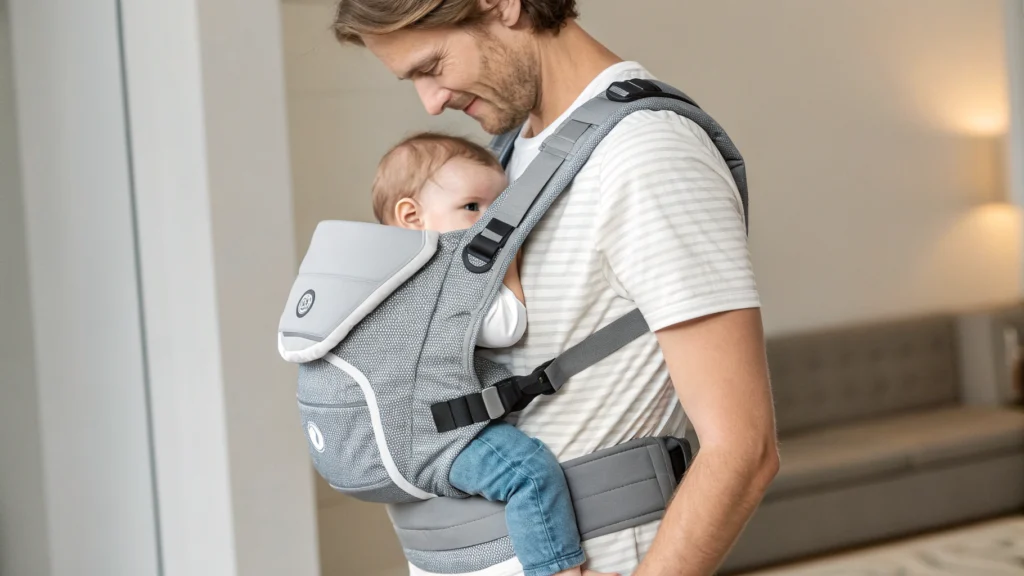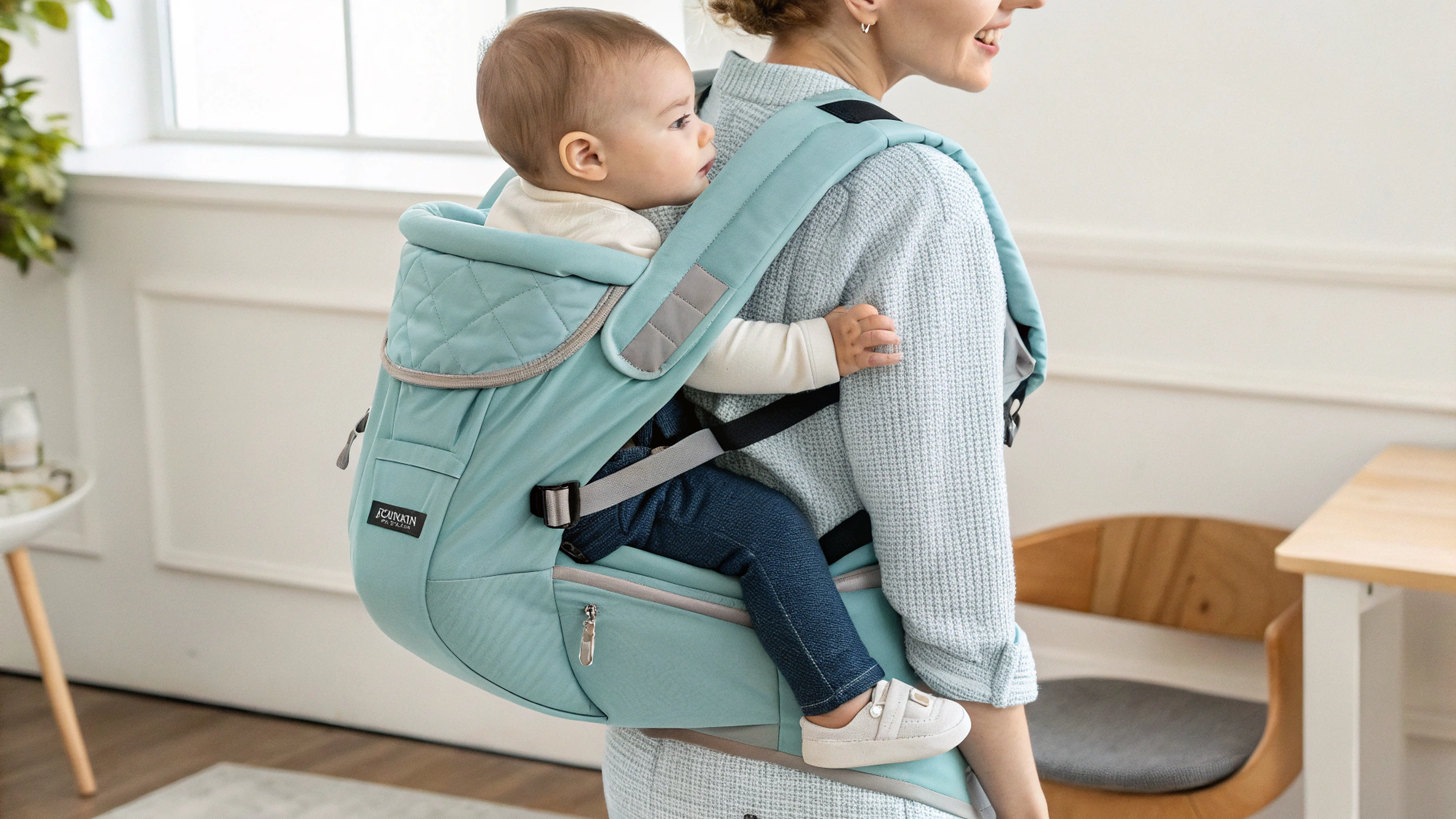Table of Contents
Parenting, and in particular carrying a little one for hours on end, is that mix of magical and exhausting no one really warns you about. I still remember my first grocery trip with my newborn tucked close in a soft wrap — sweet, but oh my back… By the time my second came along, I’d discovered the baby carrier with hip seat, and let me tell you — game changer. It wasn’t just about comfort, it was about surviving long afternoons at the park, neighborhood walks with my toddler in tow, and yes, even cooking dinner while holding a clingy baby that refused to be put down.
Why Hip Seat Carriers Matter More Than You Think
If you’ve ever tried to carry a baby on your hip for longer than 10 minutes, you know that tingling-in-the-arm feeling that says, “you’re not 22 anymore.” The thing is, traditional carriers often put all the weight on your shoulders, leaving your lower back to fend for itself. That’s where a hip baby carrier steps in and does what magic would — it redistributes the weight to your hips, your strongest support base.
Real talk? It’s not just about your comfort. Babies naturally like to be close and see the world from your level. Hip seat carriers make it easier for them to do that while keeping their little hips in a healthier “M” position (pediatricians call this hip-healthy posture). And for you, the difference between hobbling at the end of an outing and still having energy to read “Goodnight Moon” is massive.
Key Features to Look For in a Baby Carrier With Hip Seat
Finding the right model isn’t just about color or brand name — it’s about matching your lifestyle, your baby’s needs, and yes, your budget.
1. Comfort for You and Baby
Look for extra-wide waistbands that distribute weight evenly. Padding on the hip seat itself protects baby’s thighs, and breathable fabrics keep you from overheating during summer errands.
2. Versatility in Positions
Good models let you carry front-facing in, front-facing out, or even on your back. Honestly, having multiple positions saved me on those days when my baby was curious about the world one minute and burying their face in my chest the next.
3. Storage and Extras
Some hip carriers come with bonus storage pouches for keys, pacifiers, or your phone — sounds small, but it keeps you from digging through a diaper bag (while juggling a baby) just to find wipes.
4. Ergonomic Design
The International Hip Dysplasia Institute recommends a seated position over dangling legs. A proper plush seat will ensure your baby’s knees stay higher than their bottom.
My Top Picks for Hip Seat Baby Carriers
Over the years, I’ve tested quite a few. Some were dreamy right out of the box. Others… let’s just say they live somewhere in my closet.

1. Ergobaby Omni Breeze with Hip Seat
Pros: Exceptional lumbar support, breathable mesh, multiple carry modes.
Cons: Pricey, bulkier than a minimalist wrap.
2. TushBaby Hip Seat Carrier
Pros: Super fast on-and-off design, great for quick errands, simple and lightweight.
Cons: Doesn’t have upper body straps, so less support over long periods.
3. MiaMily HIPSTER Plus 3D
Pros: 6 carry positions, integrated storage pouch, orthopedic seat.
Cons: Slightly heavier; can get warm in high temps.
How to Use a Hip Seat Carrier Without Feeling Like You Need a Manual
I wish someone had told me this sooner: you don’t have to get it perfect the first time. Most good baby carrier with hip seat designs are intuitive after a few tries.
- Start at Home: Practice strapping it on and off in front of a mirror before heading out.
- Dress Smart: Light layers work best; the carrier adds warmth.
- Check Baby’s Seat: Knees higher, legs in that nice “M” shape.
- Distribute Weight: Tighten the waistband low on your hips for stability.
- Keep Essentials Handy: Use built-in pockets so you’re not rummaging around.
Budget-Friendly Tips and DIY Thoughts
Hip seat carriers can range anywhere from $40 to $150+, but here’s how I’ve made it work without draining the bank account:
- Watch for gently-used deals in parent Facebook groups or consignment shops. Babies grow fast — people often sell carriers that look brand new.
- Consider multipurpose models (some convert into standard soft carriers). One purchase, more ways to use.
- DIY fabric covers to make cleaning faster instead of washing the whole carrier.
FAQ – Your Hip Seat Questions Answered
Q: Are hip seat carriers safe for newborns?
A: Most are designed for babies older than 3–4 months with good head control. You can use inserts for younger infants, but always check manufacturer guidelines.
Q: Will it hurt my hips?
A: If worn and adjusted properly, it should actually reduce hip and back pain. The key is proper positioning and fit to your body.
Q: Can partners of different sizes use the same carrier?
A: Absolutely — just choose one with an adjustable waistband. I’ve swapped mine between me (5’3″) and my 6′ partner with no trouble.
Q: Front-facing or inward-facing — which is better?
A: For newborns, inward-facing supports bonding and neck strength. As babies get older and more curious, they’ll probably love seeing the world forward-facing.
Final Thoughts – Why I’ll Always Keep Mine
If you’re anything like me, there’s this sweet ache in parenting — you want to hold them close and smell their soft little heads… but your body sometimes begs you to put them down. With an baby carrier with hip seat, you don’t have to choose between closeness and comfort. It gives you more “yes” days — yes to playground trips after work, yes to long walks, yes to holding your baby during sunset.
Whether you go for a sleek, minimalist version or a fully-loaded hip baby carrier with pockets and padding, the real gift is freedom — for your hands, your back, and your moments together.
So next time you find yourself bouncing a baby on one hip, trying to do literally anything one-handed… trust me, it’s worth the upgrade.
